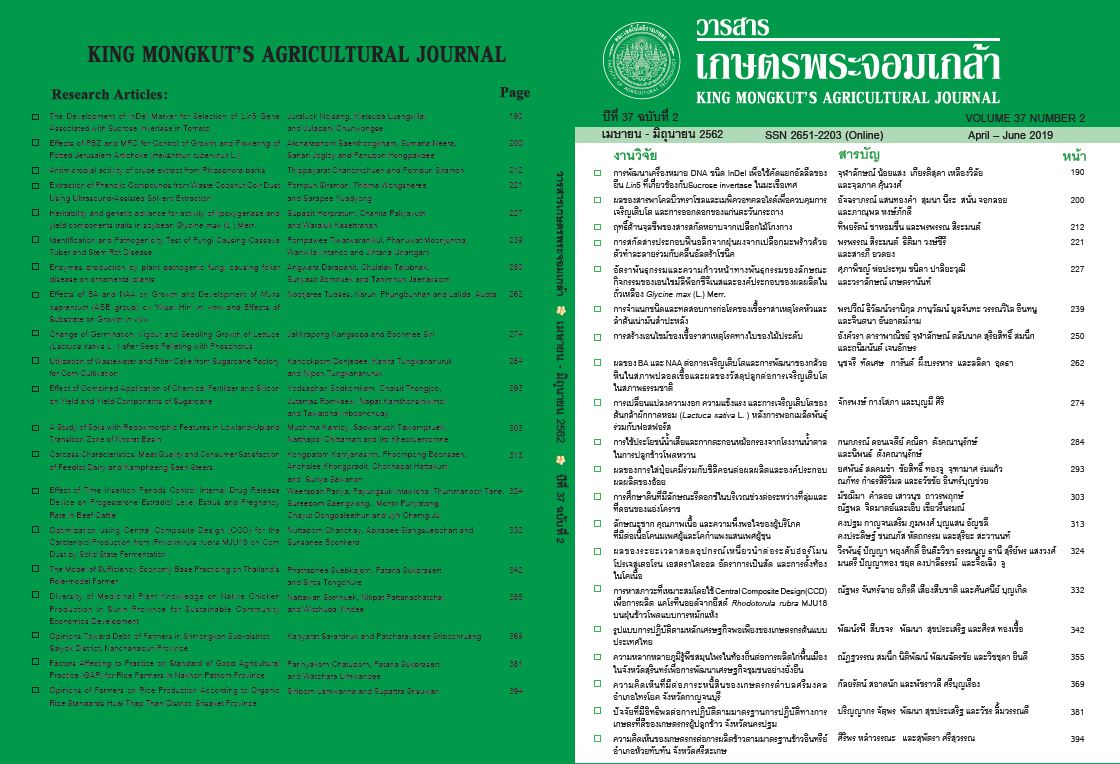อัตราพันธุกรรมและความก้าวหน้าทางพันธุกรรมของลักษณะกิจกรรมของเอนไซม์ลิพ็อกซีจีเนส และองค์ประกอบของผลผลิตในถั่วเหลือง Glycine max (L.) Merr.
Main Article Content
บทคัดย่อ
งานวิจัยนี้ได้สร้างประชากร RIL จำนวน 146 สายพันธุ์ โดยใช้คู่ผสมระหว่างพันธุ์ ‘นครสวรรค์ 1’ กับ ‘AGS129’
เพื่อประเมินค่าความแปรผันทางพันธุกรรม อัตราพันธุกรรม และความก้าวหน้าทางพันธุกรรม สำหรับลักษณะกิจกรรม
ของเอนไซม์ลิพ็อกซีจีเนสและองค์ประกอบของผลผลิตในถั่วเหลือง ประชากร RIL 146 สายพันธุ์ และพันธุ์พ่อแม่ปลูก
โดยวางแผนการทดลองแบบสุ่มในบล็อกสมบูรณ์ (RCBD) จำนวน 2 ซ้ำ เก็บข้อมูลลักษณะต่าง ๆ ทางพืชไร่ ได้แก่ วัน
ออกดอก ความสูง จำนวนเมล็ดต่อฝัก จำนวนฝักต่อต้น และจำนวนเมล็ดต่อต้น วัดกิจกรรมจำเพาะของเอนไซม์ลิพ็อก
ซีจีเนสในเมล็ดถั่วเหลืองโดยใช้เครื่องวัดค่าการดูดกลืนแสงที่ 234 นาโนเมตร จากผลการทดลองแสดงว่าลักษณะกิจกรรม
ของเอนไซม์ลิพ็อกซีจีเนส มีค่าสัมประสิทธิ์ความแปรปรวนทางพันธุกรรมอยู่ในระดับสูง (GCV = 23.053%) และมีค่า
อัตราพันธุกรรมในแนวกว้างอยู่ในระดับปานกลาง (Hb
2 = 42.774%) จากผลการทดลองแสดงว่าพันธุกรรมมีอิทธิพลต่อ
การแสดงออกของลักษณะนี้มาก นอกจากนี้ลักษณะจำนวนเมล็ดต่อต้นและจำนวนฝักต่อต้นมีค่าสัมประสิทธิ์ความ
แปรปรวนทางพันธุกรรมและค่าอัตราพันธุกรรมในแนวกว้างอยู่ในระดับสูง ลักษณะจำนวนเมล็ดต่อต้นมีความก้าวหน้า
ทางพันธุกรรมสูงที่สุด (GAM = 123.359%) เช่นเดียวกัน จากผลการทดลองนี้เห็นได้ว่าลักษณะองค์ประกอบของผลผลิต
ถูกควบคุมด้วยอิทธิพลของยีนแบบบวก ข้อมูลที่ได้นี้สามารถนำไปใช้เป็นประโยชน์ในโครงการปรับปรุงพันธุ์สำหรับคัด
เลือกลักษณะกิจกรรมของเอนไซม์ลิพ็อกซีจีเนสและลักษณะองค์ประกอบของผลผลิตในถั่วเหลืองได้
Article Details
วารสารเกษตรพระจอมเกล้า
เอกสารอ้างอิง
กับลักษณะผลผลิตของถั่วเหลือง Glycine max (L.) Merr. ในประเทศไทย. น.38-48. ใน การประชุมวิชาการ พืชไร่วงศ์ถั่วแห่งชาติ
ครั้งที่ 5. 25-27 สิงหาคม 2558. โรงแรมทีคการ์เด้นสปารีสอร์ท จ.เชียงราย.
Aditya, J.P., Bhartiya, P. and Bhartiua, A. 2011. Genetic variability, heritability and character association for yield and
component characters in soybean (G. max (L.) Merrill). Journal of Central European Agriculture. 12 : 27-34.
Ariyo, O.J. 1995. Correlation and path-coefficient analysis of component of yield in soybean. African Crop Science Journal.
3 : 29-33.
Chowdhury, A.K., P. Srinives, P. Saksoong, and P. Tongpamnak. 2002. RAPD markers linked to resistance to downy mildew
disease in soybean. Euphytica. 128 : 55-60.
Desissa, D.H. 2017. Genetic variability, heritability and genetic advances of soybean (Glycine max (L.) Merrill) varieties
grown at Bako Tibe in Western Ethiopia. Asian Journal of Plant Science and Research. 7 : 20-26.
Doehlert, D.C., D.T. Wicklow, and H.W. Gardner. 1993. Evidence implicating the lipoxygenase pathway in providing
resistance to soybeans against Aspergillus flavus. Resistance. 83 : 1473-1477.
Falconer, D.S. and T.F.C. Mackay. 1996. Introduction to Quantitative Genetics, Ed 4. Longmans Green, Harlow, Essex, UK.
Fehr, W.R. 1987. Principles of Cultivar Development volume 1 Theory and Techniques. New York, USA: McGraw-Hill Inc.
Johnson, H.W., H.E. Robinson, and R.E. Comstock. 1955. Estimates of genetic and environmental variability in soybean.
Agronomy. 47 : 314-318.
Kato, T., Y. Maeda, T. Hirukawa, T. Namai, and N. Yoshioka. 1992. Lipoxygenase activity increment in infected tomato
leaves and oxidation product of linolenic acid by its in Vitro enzyme reaction. Bioscience, Biotechnology,
and Biochemistry. 56 : 373-375.
Kim, M.Y., B.K. Ha, T.H. Jun, E.Y. Hwang, V. Kyunjung, Y. Kuk, and S.H. Lee. 2004. Single nucleotide polymorphism
discovery and linkage mapping of lipoxygenase-2 gene. Euphytica. 135 : 169-77.
Koch, E., B.M. Meier, H-G. Eiben, and A. Slusarenko. 1992. A lipoxygenase from leaves of tomato (Lycopersicon esculentum
Mill.) is induced in response to plant pathogenic pseudomonads. Plant Physiology. 99 : 571-576.
Kondo, Y., Y. Kawai, , T. Hayashi, , M. Ohnishi, T. Miyazawa, , S. Itoh, and J. Mizutani. 1993. Lipoxygenase in soybean
seedlings catalyzes the oxygenation of phospholipid and such activity changes after treatment with fungal elicitor.
Biochimica et Biophysica Acta. 301-306.
Kruger, N.J. 2009. The bradford method for protein quantitation. The Protein Protocols Handbook 3rd edition. United
Kingdom : Humana Press. 17-24.
Kumar, V., A. Rani, P. Jha, L. Hussain, V. Pal, V. Petwal, P. Kumar, and J. Dwivedi. 2017. Lipoxygenase and tocopherol
profiling of soybean genotypes exposed to electron beam irradiation. Journal of the American Oil Chemists’ Society.
94 : 457-463.
Kumar, V., A. Rani, V. Mourya, and R. Rawal, 2011. Parental polymorphism survey of popular soybean varieties in
combination with the source of null alleles of kunitz tryspin inhibitor and lipoxygenase-2 using linked SSR markers.
Soybean Research. 9 : 72-78.
Levesque, R. 2007. SPSS Programming and Data Management: A Guide for SPSS and SAS Users, 4th edition. Chicago :
Raynald Levesque and SPSS Inc. 22-189.
Macleod. G., J. Ames, and N.L. Betz. 2009. Soy flavor and its improvement. Critical Reviews in Food Science and Nutrition.
4 : 219-400.
Nagarajan, D., T. Kalaimagal, and E. Murugan, 2017. Evaluation of genetic parameters in M4 generation of soybean mutant
lines. International Journal of Current Microbiology and Applied Sciences. 6 : 2902-2906.
Ohta, H., K. Shida, Y-L. Peng, I. Furusawa, J. Shishiyama, S. Aibara, and Y. Morita 1991. A Lipoxygenase pathway is
activated in rice after infection with the rice blast fungus Magnaporthe grisea. Plant Physiology. 97 : 94-98.
Okoye, M.N., C.O. Okwuagwu, and M.I. Uguru. 2009. Population improvement for fresh fruit bunch yield and yield
components in oil palm (Elaeis guineensis Jacq.). American-Eurasian Journal of Scientific Research. 4 : 59-63.
Permyakova, M.D. and V.A. Trufanov. 2010. Effect of soybean lipoxygenase on baking properties of wheat flour. Applied
Biochemistry and Microbiology. 47 : 315-320.
Reinprecht, Y., V.W. Poysa, I. Rajcan, G.R. Ablett, and K.P. Pauls. 2005. Agronomic performance of soybean with seed
lipoxygenase nulls and low linolenic acid content. Canadian Journal of Plant Science. 379-387.
Reni, Y.P. and Y.K. Rao. 2013. Genetic variability in soybean [Glycine max (L) Merrill]. International Journal of Plant, Animal
and Environmental Science. 3 : 35-38.
Robinson, H.F., R.E. Comstock, and V.H. Horvey. 1949. Estimates of heritability and degree of dominance in Soybean.
Agronomy Journal. 41 : 353-359.
Rongwen, J., M.S. Akkaya, A.A. Bhagwat, U. Lavi, and P.B. Cregan, 1995. The use of microsatellite DNA markers for soybean
genotype identification. Theoretical and Applied Genetics 90 : 43-48.
Shivasubramanian, S. and M. Menon. 1973. Hetrosis and inbreed depration in soybean. Madras Agricultural Journal. 60 : 1139.
Singh, R.K. and B.D. Chaudhary. 1979. Biometical Methods in Quantitative Genetic Analysis. Kalyani Publishers.
Sirikesorn, L., W. Imsabai, S. Ketsa, and W.G. van Doorn. 2015. Ethylene-induced water soaking in Dendrobium floral buds,
accompanied by increased lipoxygenase and phospholipase D (PLD) activity and expression of a PLD gene.
Postharvest Biology and Technology. 108 : 48-53.


